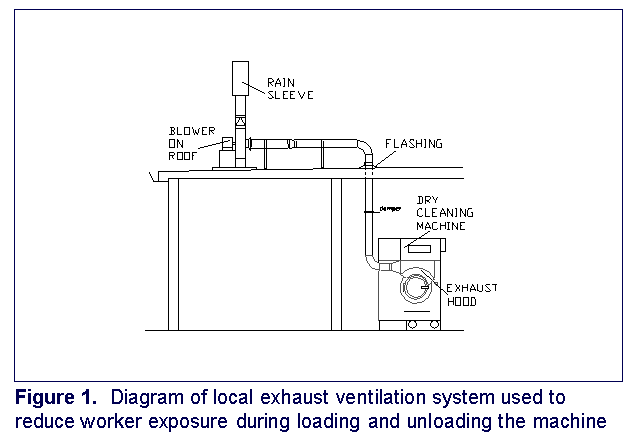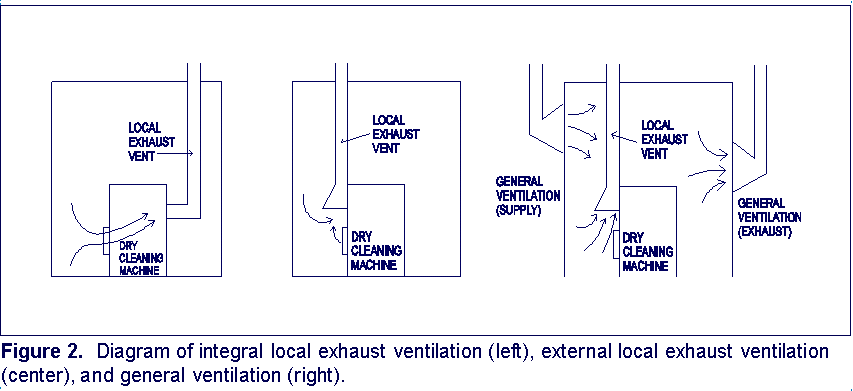Control of Exposure to Perchloroethylene in Commercial Drycleaning (Ventilation)
1997
DHHS (NIOSH) Publication Number 97-157
Hazard
Perchloroethylene (PERC) is the most commonly used drycleaning solvent. PERC can enter the body through respiratory and dermal exposure. Symptoms associated with exposure include: depression of the central nervous system; damage to the liver and kidneys; impaired memory; confusion; dizziness; headache; drowsiness; and eye, nose, and throat irritation. Repeated dermal exposure may result in dermatitis. NIOSH considers PERC a potential human carcinogen.
Controls
To reduce exposure to drycleaning solvents, a comprehensive control approach should be followed involving engineering measures, work practices, and personal protection. Engineering measures are the preferred and most effective means of control and should generally be considered first. One of the potentially least expensive engineering control options for reducing worker exposures to PERC involves effective ventilation.
Ventilation
- Ventilation should be used to control worker exposure to PERC and ensure thermal comfort. Both measures are important in drycleaning. Control techniques that eliminate or reduce PERC exposure by capturing vapors should be used first. Ventilation does not eliminate vapors; rather, it can prevent vapors from reaching the worker’s breathing zone. Ventilation control should be accomplished by capturing and removing the contaminant at or near the source (local ventilation), or diluting the concentration of the contaminant before it reaches the worker’s breathing zone (general ventilation).
Local Exhaust Ventilation(LEV)
- LEV captures the vapor at or near its source of release. This ventilation technique reduces the vapor level reaching the worker’s breathing zone and minimizes vapor diffusion. Vapor diffusion is one cause of background ambient air PERC concentrations throughout the shop. In drycleaning shops, the release of PERC vapors into the environment and subsequent worker exposure to PERC vapors is greatest during machine maintenance and loading and unloading. Drycleaning machines that use LEV as a control should have an inward air velocity of 100 fpm through the loading and unloading door (known as the door’s face velocity). This velocity helps reduce solvent vapors escaping into the shop by providing a draft of clean air passing over the items being removed from the machine. Exhaust from the machine should be ducted to a point 5 ft above the roof to prevent reentry to the work environment or entry to adjacent establishments. LEV systems are typically activated by a door interlocking switch.
- An alternative for older machines without built-in exhaust ventilation is to retrofit an external ventilation hood outside the machine door. Airflow capacity in cfm through this retrofit hood should not be less than 100 times the door opening area in square feet (i.e., a 4 ft2 door opening would need an exhaust hood flow rate at least 400 cfm) (Figure 1). The exhaust hood should be isolated from cross drafts caused by general ventilation, floor or other shop fans, and high personnel traffic areas.
General Ventilation
- General ventilation, also known as dilution ventilation, should be used to supply conditioned fresh air and to exhaust contaminated air from the general workroom area. This ventilation technique can provide temperature control and reduce background levels of PERC in the drycleaning shop. Generally accepted guidelines recommend an air change in the workroom every 5 min with a minimum of 30 cfm of outside air per person. Supply and exhaust systems within the shop should move air from a clean area (offices, customer counters, etc.) to a less clean area (where the drycleaning machine is located). This process reduces movement of contaminated air into other areas of the shop. Exhaust fans should pull fresh air through the drycleaning area, drawing vapors away from the workers. Make-up air, which replaces the air exhausted to the outside, enters naturally through windows and doors or through large fans in the ceiling or walls. Insufficient volumes of make-up air could cause an outward flow of contaminated air from the drycleaning area. A qualified ventilation system contractor should be contacted to assist with this work. A diagram of both local and general ventilation systems is shown in Figure 2.
Emergency Ventilation
- Emergency ventilation systems should be available to control solvent vapors if a solvent spill or leak occurs.


A NIOSH technical report, Control of Health and Safety Hazards in Commercial Drycleaners: Chemical Exposures, Fire Hazards, and Ergonomic Risk Factors, has been published on this subject. This document is one in a series of seven HAZARD CONTROLS concerning control of hazards in the drycleaning industry that are available free upon request.
*NIOSH is the Federal agency responsible for conducting research and making recommendations for preventing work-related illnesses and injuries. All HAZARD CONTROLS are based on research studies that show how worker exposures to hazardous agents or activities can be significantly reduced.
Acknowledgements
The principal contributors to this publication are Gary S. Earnest, Charles S. Hayden, Daniel S. Watkins, Rosmarie T. Hagedorn, and Jerome P. Flesch.
This document is in the public domain and may be freely copied or reprinted. NIOSH encourages all readers of this HAZARD CONTROLS to make it available to all interested employers and workers.
Control of Exposure to Perchloroethylene in Commercial Drycleaning (Ventilation)
